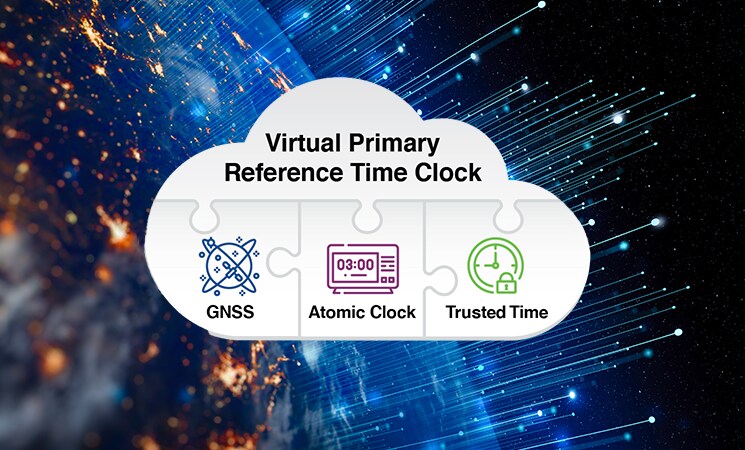Choosing Virtual Primary Reference Timing Clocks — for Accuracy, Precision and Security
Virtual Primary Reference Timing Clock (vPRTC) is a new concept for a highly secure and protected network-based timing architecture developed to meet the expanding needs of modern critical infrastructures.

An urgent call to action is under way to assure security and resiliency of timing systems used in critical infrastructure including communication networks, transportation, energy and data centers. The Global Navigation Satellite System (GNSS) has been deployed successfully across these industries as the only way to deliver local 100ns timing solutions to rapidly growing areas of need. The result has been exponential growth of highly accurate point timing solutions in mission critical applications.
Today, however, it is not enough to simply deliver an accurate timing instance.
Critical infrastructure operators need to consider their overall timing hygiene and know that their source of timing can be trusted, that it is validated and that they have network wide visibility and monitoring. And importantly, that they have resiliency in the form of backups and protection for when something goes wrong.
The Virtual Primary Reference Timing Clock (vPRTC) is a new concept for a highly secure and protected network-based timing architecture, developed to meet the expanding needs of modern critical infrastructures. vPRTC is simple in concept blending proven timing technologies into a centralized and protected source location, and then utilizing commercial fiberoptic network links and advanced IEEE-1588 Precision Time Protocol (PTP) high accuracy boundary clocks to distribute PRTC 100ns level timing to end points hundreds of kilometers away where it is needed.
Let’s explore a brief overview of how the vPRTC resilient timing architecture can benefit critical infrastructures:
• Power Utilities – Modern smart-power grids are complex networks that are highly dependent on precise and resilient timing to assure control and communication for efficient and continuous and safe supply of power. The vPRTC architecture reduces dependency on GNSS while providing increased resiliency and protection.
• Transportation – The rail and air transport industries’ secure communication networks rely on precise synchronization and timing to assure reliable transportation and public safety. The vPRTC architecture supports industry migration to packet networks.
• Data Centers – Accurate and resilient timing is critical to data centers to ensure high-speed transactions occur sequentially, and can be coordinated across geographically dispersed locations. The vPRTC provides precise synchronization for geographically-distributed data centers and is independent from local GNSS systems.
• 5G Communication Networks – 5G network infrastructure requires extremely tight synchronization at all points in its highly-distributed architecture. The vPRTC architecture provides protected PRTC quality timing to each node on the network without the need for local GNSS timing systems.
One of the first industries to adopt the vPRTC architecture is communication networks, which have a long history of using centralized cesium atomic clocks and network-based clock distribution technologies. With 5G exploding – and with the increased need for PRTC 100ns level timing in more and more locations – operators are looking for more protected and resilient ways to deliver timing for their 5G networks.
The 5G architecture imposes the use of PTP as the primary timing protocol for delivery of timing to the Radio Units (RU). The biggest question is where to locate the source PRTC. There is not a natural demark point in 5G transport networks such as the BBU in 4G. That challenge can be solved by deploying the vPRTC where every point on the network can be at the equivalent PRTC performance level of 100ns.
Key elements of the vPRTC resilient timing architecture for 5G timing and synchronization needs include:
• Core Area Timing Hubs comprised of:
o Cesium atomic clocks
o TimeProvider 4100 ePRTC
o BlueSky GNSS Firewall protection
• Optical transport networks with advanced PTP boundary clocks enabling bidirectional timing flows for redundant protection
• TimeProvider 4100 Gateway Clocks at the 5G access sites
• TimePictra Synchronization Management with advanced monitoring
As networks evolve through the next phase of advanced 5G services an increasing requirement will exist for even more precise timing to the edge of the network. Operators will require long-term stability and predictability of the timing network, while ensuring low cost, flexibility and adaptability when engineering the service layers.
vPRTC is a new concept for a highly secure and protected network-based timing architecture developed to meet the expanding needs of modern critical infrastructures.
Please visit Mirochip vPRTC to learn more and download Microchip’s vPRTC white paper.
Contact your Microchip representative to learn more about how our solutions enable operators to build vPRTC networks delivering ultra-high precision timing services with unmatched stability, security and reliability.